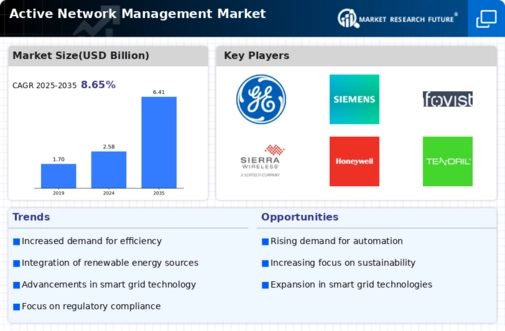Market Share
Active Network Management Market Share Analysis
The Active Network Management (ANM) market is influenced by a variety of factors that collectively shape its growth and impact its dynamics. One of the primary drivers is the increasing complexity of modern power systems. With the integration of renewable energy sources, energy storage systems, and the proliferation of distributed energy resources, utilities and grid operators face the challenge of managing a more dynamic and decentralized network. Active Network Management solutions address this challenge by providing real-time monitoring, control, and optimization capabilities to enhance grid reliability and efficiency.
The transition to smart grids and the deployment of advanced metering infrastructure contribute significantly to the dynamics of the ANM market. As utilities strive to modernize their infrastructure and improve grid intelligence, ANM solutions play a crucial role in enabling the integration and management of diverse energy assets. The demand for real-time visibility and control over grid operations drives the adoption of ANM technologies, facilitating the effective incorporation of renewable energy and promoting grid stability.
Grid reliability and resilience are key considerations influencing the ANM market. The ability of ANM solutions to quickly detect and respond to grid disturbances, faults, and fluctuations contributes to the overall resilience of the power system. Utilities and grid operators invest in ANM technologies to enhance the reliability of their networks, minimize downtime, and improve the overall performance of the electricity grid.
Regulatory frameworks and policies play a pivotal role in shaping the ANM market. Governments and regulatory bodies worldwide are recognizing the importance of active network management in achieving energy efficiency, reducing greenhouse gas emissions, and fostering grid modernization. Supportive policies and incentives encourage utilities to adopt ANM solutions, driving market growth and influencing the development of smart grid infrastructure.
The growing emphasis on energy efficiency and sustainability contributes to the adoption of ANM solutions. By optimizing the operation of the power grid, ANM technologies help reduce energy losses, enhance resource utilization, and support the integration of renewable energy sources. As businesses and communities prioritize sustainability goals, the implementation of ANM becomes a strategic component in achieving a more environmentally friendly and efficient energy system.
Technological advancements and innovation are inherent to the ANM market. Continuous research and development efforts focus on improving the capabilities of ANM solutions, including advanced analytics, machine learning, and artificial intelligence. These technological enhancements enable more sophisticated and adaptive control strategies, allowing ANM systems to respond dynamically to changing grid conditions and emerging challenges.
Market competition among ANM solution providers influences the overall landscape of the industry. Vendors strive to differentiate themselves by offering comprehensive and scalable solutions that cater to the evolving needs of utilities and grid operators. Strategic partnerships, collaborations, and mergers and acquisitions contribute to the competitive dynamics of the ANM market, shaping the market share and influence of key players.
Cybersecurity considerations are critical in the ANM market, given the interconnected and digitized nature of modern power systems. ANM solutions rely on communication networks and data exchange, making them susceptible to cybersecurity threats. Robust cybersecurity measures and adherence to industry standards are essential for ensuring the integrity and security of ANM systems, influencing the adoption and deployment strategies of utilities.
Interoperability and standardization efforts impact the ANM market. As the industry evolves, the need for interoperable solutions that can seamlessly integrate with existing grid infrastructure becomes crucial. Standardization initiatives contribute to the development of a more cohesive and interconnected energy ecosystem, facilitating the widespread adoption of ANM technologies.

















Leave a Comment